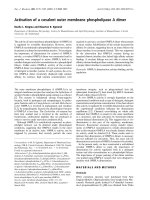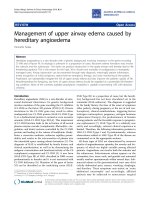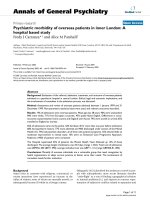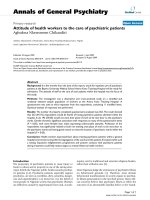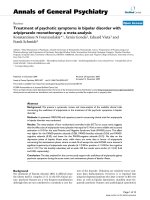Báo cáo y học: " Lack of agreement between bioimpedance and continuous thermodilution measurement of cardiac output in intensive care unit patient" ppt
Bạn đang xem bản rút gọn của tài liệu. Xem và tải ngay bản đầy đủ của tài liệu tại đây (273.69 KB, 4 trang )
RESEA R C H Open Access
Lack of agreement between bioimpedance and
continuous thermodilution measurement of
cardiac output in intensive care unit patients
Ben N Barry
1
, Abhiram Mallick
1
, Andrew R Bodenham
2
, Michael Vucevic
1
Abstract
Background: Bolus thermodilution is the standard bedside method of cardiac output measurement in the
intensive care unit (ICU). The Baxter Vigilance monitor uses a modified thermodilution pulmonary artery catheter
with a thermal filament to give a continuous read-out of cardiac output. This has been shown to correlate very
well with both the ‘gold standard’ dye dilution method and the bolus thermodilution method. Bioimpedance
cardiography using the Bomed NCCOM 3 offers a noninvasive means of continuous cardiac output measurement
and has been shown to correlate with the bolus thermodilution method. We investigated the agreement between
the continuous bioimpedance and continuous thermodilution methods, enabling acquisition of a large number of
simultaneous measurements.
Results: A total of 2390 paired data points from seven patients were collected. There was no correlation (r
2
= 0.01)
between the methods. The precision (1.16 l/min/m
2
) of agreement between the Vigilance and the Bomed,
assessed by the Bland-Altam method, was very poor although the bias (-0.16 l/min/m
2
) appeared fair.
Conclusions: The Bomed NCCOM 3 bioimpedance monitor shows poor agreement with the Baxter Vigilance
continuous thermodilution monitor in a group of general ICU patients and cannot be recommended for cardiac
output monitoring in this situation.
measurement techniques impedance cardiography, thermodilution, monitoring, cardiac output
Introduction
The fluid bolus thermodilution method of cardiac out-
put measuremen t, using a pulmonary artery cat heter
(PAC), has gained wide acceptan ce over the past 25
years. The advantages a nd disadvantages of the use of
this method of monitoring critically ill patients are well
established [1].
A recent development has been the introduction of
‘continuous’ cardiac output monitoring using a modified
PAC (Continuous Cardiac Output/SvO
2
Catheter model
746H8F, Baxter Healthcare Corporation, Round Lake,
Illinois, USA). This catheter has a thermal filament that
produces pulses of heat at the level of the right ventri-
cle, and a thermistor at the tip in the pulmonary artery
senses temperature change. A dedicated computer
(Vigilance, Baxter Healthcare Corporation) is required,
which updates calculate d cardiac output every 30–60 s.
This system has been previously investigated [2] and has
shown a very strong correlation with bo th the ‘gold
standard’ dye dilution technique (r
2
= 0.91) and fluid
bolus thermodilution (r
2
= 0.97). It has also been evalu-
ated specifically for use in critically ill patients [3] and
in a bench model of pulmonary artery blood flow [4].
Bioimpedance cardiography h as been developed over
the past 30 years as a noninvasive technique to measure
cardiac output. Monitors such as the Bomed Noninva-
sive Computerized Cardiac Output Monitor (NCCOM
3, Bomed Medical Manufacturing Ltd, Cheshire, UK)
are commercially available to measure cardiac output.
However, in the United Kingdom and elsewhere they
have not achieved widespread usage. The NCCOM 3
uses eight spot electrodes, placed at the root of the neck
and chest wall. A constant sinusoidal alternating current
(2.5 mA rms, 70 kHz) is passed through the subject’s
1
Academic Unit of Anaesthesia, The General Infirmary at Leeds, Great George
Street, Leeds LS1 3EX, UK
Full list of author information is availabl e at the end of the article
Barry et al. Critical Care 1997, 1:71
©1997CurrentScienceLtd
chest and the impedance measured. By measuring the
maximum rate of change of thoracic impedance during
systole, timed from the electrocardiogram (ECG), the
stroke volume is calculated. The Sramek-Bernstein for-
mula is used, which calculates stroke volume as the
volume of electrically participating intrathoracic tissue ×
ventricular ejection time × index of contractility, which
is the ratio of the peak rate of change in thoracic bioim-
pedance and the thoracic fluid index (or total thoracic
impedance). Cardiac output is then calculated from the
product of heart rate and stroke volume, averaged over
16 cardiac cycles.
We have investigated the correlation between these
two methods of continuous cardiac output measurement
to determine their suitability for use in critically ill
patients in the intensive care unit (ICU).
Methods
We compared the Bomed NCCOM 3 with the Baxter
Vigilance in a mixed group of seven ICU patients. All
patients required pulmonary artery catheterization on
clinical grounds. In two patients, an existing PAC was
exchanged for a continuous cardiac output PAC, using
the same introducer sheath. An explanation of the use
of noninvasive bioimpedence monitoring as part of a
research study was given to the patie nts’ relatives and
assent was obtai ned. The primary patholo gies of the
patients were acute pancreatitis (one), emer gency repair
of an abdominal aortic aneurysm (two), appendix
abscess (one), probable pulmonary embolism (one), cho-
langitis following ch olecystectom y (one) and respiratory
failure (one). The study was purely observational, and
required no alterations in therapy.
For bioimpedance cardiography, eight standard ECG
gel electrodes and, if necessary, two additional electro-
des for ECG monitoring were applied, according to
directions printed on the NCCOM 3 monitor. Timed
data points were saved on a personal laptop computer
connected to the NCCOM 3 using the CDDP version SI
4.05 software (CDIc, Irvine, California, USA).
For thermodilution measurements, a continuous car-
diac output PAC connected to the Vigilance monitor
was inserted via the internal jugular or subclavian vein.
Timed data was stored in the patient monitoring system
(Hewlett Packard Ltd, Boise, Idaho, USA), using the
‘Vue-link’ software to connect the two devices. A print-
out of cardiac output data at 1-min intervals was
obtained at the end of the study period.
Any discrepa ncy between the clocks on the two moni-
tors was accounted for by noting the times displayed at
the start of measurement and allowing for this when
pairing the data. In this way we ensured that the paired
data points were accurately synchronized.
Body surface area was calculated by each device in
order to obtain ‘indexed’ measurements, by en tering the
patients’ height and weight, estimated i f necessary. We
verified that both devices produced the same body sur-
face area, so eliminating this source of bias error.
Each patient was monitored for a period of approxi-
mately 6 h, acquiring simultaneous pai red cardiac index
data points at 1-min intervals. The data points were
analysed using SPSS for Windows release 6.1 (SPSS Inc,
Chicago, Illinois, USA) and r
2
was calculated using
regression analysis. A plot of the difference between
measurements against the mean of the measurements
was then constructed according to the technique for
assessing agreement between two methods of clinical
measurement described by Bland and Altman [5].
Results
Seven patients were studied; the mean (± SD) age was
63 ± 16 years, mea n weight 86 ± 31 kg and mean body
surface area 2.0 ± 0.34 m
2
. A total of 2390 simultaneous
paired cardiac index data points were analysed, with
approximately equal numbers of data points from each
patient. The patients were all mechanically ventilated;
other ongoing supportive care included vasopressor and
inotropic support and renal replacement therapy (con-
tinuous haemofiltration or intermittent haemodialysis)
as required by the individual patient. Positive end-
expiratory pressure (PEEP) was used as clinically indi-
cated, up to 10 cm H
2
O. During the study none of the
patients suffered new dysrhythmias requiring treatment
or interfering with cardiac output measurement.
The range of cardiac index measurements was 1.40–
7.20 l/min/m
2
(mean 3.50 ± 0.95 l/min/m
2
), by the
Bomed, and 1.60–5.60 l/min/m
2
(mean 3.65 ± 0.77 l/
min/m
2
) by the Vigilance monitor. There was essentially
no relationship between the two methods (r
2
=0.01;Fig
1). The correlation coefficients for indivi dual patients
were -0.25, -0.21, 0.41, 0.25, -0.39, -0.16 and 0.06,
respectively.
A Bland–Altman plot (Fig 2) showed a poor degree of
agreement between the methods. Although the degree
of bias was acceptable, the precision was very poor. The
mean of the differences (bias) was -0.16 l/min/m
2
,but
with a standard deviation (precision) of ± 1.16 l/min/m
2
.
The lower and upper limits of agreement were -2.48 and
2.16 l/min/m
2
respectively. Bland–Altman analysis of
individual patients showed bias measurements of -1.31,
-0.95, 0.28, 0.59, 0.88, 0.76 and -1.32 l/min/m
2
,with
precision of 0.59, 0.63, 0.59, 0.61, 1.10, 0.60 and 0.74 l /
min/m
2
, respectively. Three of the patients showed a
poor precision throughout the measured range of car-
diac output. The other four patients showed a fair
degree of precision, but with a changing bias, from
Barry et al. Critical Care 1997, 1:71
Page 2 of 4
negative to positive, with increasing cardiac output.
There were no clear factors which could be used to pre-
dict which group individual patients would fall into.
Discussion
The morbidity and mortality associated w ith the use of
PACs is well recognized and must be weighed against
the potential benefits for the individual patient of gain-
ing valuable information regarding the cardiovascular
system and oxygen delivery [6]. Bioimpedance cardiogra-
phy offers an apparently attractive noninvasive way of
estimating cardiac output and obtaining derived haemo-
dynamic parameters. However, this is of no benefit if
the information acquired is unreliable, leading to inap-
propriate management. We investigated the use of
bioimpedance in the critically ill to assess whether it can
be a reliable method of cardiac output measurement for
this group of patients.
The thermodilution method is an indirect measure of
cardiac output, but has been shown to correlate well
with the gold standard dye dilution method. Moreover,
itisthemethodmostcommonlyusedtomeasure
Figure 1 Scatter plot of Bomed bioimpedance vs Vigilance thermodilution continuous measurement of cardiac index (r
2
= 0.01).
Figure 2 Bland–Altman plot of difference in cardiac index measu red by bioimpedance cardiography (bi) and continuous thermodilution (td)
against mean measured cardiac index (Cl; l/min/m
2
). The degree of bias (measured by the mean) and precision (± 2SD) are shown.
Barry et al. Critical Care 1997, 1:71
Page 3 of 4
cardiac output in patients in the ICU and upon which
much of our understanding of the cardiovascular
changes in critical illnesses is based.
Bioimpedance cardiography has been validated in
some patient groups [7], and newer systems with
improved software for advanced signal proce ssing may
be valid in critically ill patients [8]. Howev er, there have
been concerns raised as to its accuracy and reliability in
ICU patients [9,10]. Correct placement of the eight elec-
trodes is important in obtaining accurate information; in
ICU patients this may be hampered by dressing covering
internal jugular line sites, thoracotomy wounds and
chest drain sites. In this study, the directions for elec-
trode placement detailed on the NCCOM 3 monitor
were followed as a closely as practically possible, aiming
to reproduce the conditions that would pertain to rou-
tine clinical use of the monitor.
The use of positive pressure ventilation with PEEP,
and the presence of endotracheal tubes, chest drains
and sternal wires may affect bioimpedance measure-
ments by affecting the rate of change of thoracic impe-
dance [11]. However, cardiological studies in patients
with pacemakers have shown bioimpedance to be a use-
ful technique [12]. The presence of the thermal filament
in the modified PAC used by the Vigilance monitor may
also affect bioimpedance measurements; standard PACs
may also affect measurements by the presence of the
thermistor wire. In any case, if the b ioimpedance data
are affected by foreign material in the thorax, this
makes the use of the Bomed in ICU patients very
problematic.
The design o f this study is novel in two ways, giving
major advantages over previous studies. Firstly, by com-
paring two ‘continuous’ methods of cardiac output mea-
surement, the inevitable errors of synchronization using
intermittent methods are virtually eliminated. ( Previous
studies comparing bioimpedance with thermodilution
have needed to average several bolus measurements
before or after the acquisition of bioimpedance data.)
Secondly, we were able to collect a very large number of
simultaneous paired data points from the two m ethods,
averaged over the whole respiratory cycle, enabling a
more accurate comparison.
Thisstudyshowsthereisessentiallynorelationship
between cardiac index as measured by the Bomed
NCCOM 3 and the coninuous thermodilution method
(r
2
= 0.01); this i s surprising a s the two methods claim
to measure the same variable. There is extremely poor
agreement between the methods according to the
Bland– Altman method. The lack of precision is quite
unacceptable. From our data, a cardiac index of 4.0 l/
min/m
2
would be subject to an error of up to +54% or
-62% at the 95% limit s of agreement. Importantly, we
were able to assess the changes in measured cardiac
output in individual pat ients and these also showed
poor agreement with variable precision and bias. This
would indicate that the use of the NCCOM 3 is unlikely
to be of value even if a subgroup of patients, in whom
the precision is acceptable, could be identified.
The two methods cannot therefore be used inter-
changeably to monitor cardiac output. Furthermore,
therapeutic interventions to improve cardiovascular
function that have been shown to be b eneficial in
patients monitored by the thermodilution technique
cannot be similarly applied to patients monitored by
bioimpedance cardiography. Bioimpedance cardiography
cannot be recommended for use in critically in patients
such as this group from a general ICU.
Author details
1
Academic Unit of Anaesthesia, The General Infirmary at Leeds, Great George
Street, Leeds LS1 3EX, UK.
2
Intensive Care Unit, The General Infirmary at
Leeds, Great George Street, Leeds LS1 3EX, UK.
Received: 14 May 1997 Revised: 8 September 1997
Accepted: 12 September 1997 Published: 26 November 1997
References
1. Soni N: Swan song for the Swan-Ganz catheter? BMJ 1996, 313:763-764.
2. Haller M, Zollner C, Briegel J, Forst H: Evaluation of a new continuous
cardiac output monitor in critically ill patients: a prospective criterion
standard study. Crit Care Med 1995, 25:860-866.
3. Boldt J, Menges T, Wollbruck M, Hammermann H, Hemplemann G: Is
continuous cardiac output measurement using thermodilution reliable
in the critically ill patient? Crit Care Med 1994, 22:1913-1918.
4. Mihaljevic T, von Segesser L, Tonz M, Leskosek B, Seifert B, Jenni R,
Turina M: Continuous versus bolus thermodilution cardiac output
measurements — a comparative study. Crit Care Med 1995, 23:944-949.
5. Bland JM, Altman DG: Statistical methods for assessing agreement
between two methods of clinical measurement. Lancet 1986, I:370-310.
6. Ginosar Y, Thijs LG, Sprung CL: Raising the standard of hemodynamic
monitoring: targeting the practice or the practitioner? Crit Care Med
1997, 25:209-211.
7. Belardinelli R, Ciampani N, Costantini C, Blandini A, Purcaro A: Comparison
of impedance cardiography with thermodilution and direct Fick
methods for noninvasive measurement of stroke volume and cardiac
output during incremental exercise in patients with ischaemic
cardiomyopathy. Am J Cardiol 1996, 77:1293-1301.
8. Shoemaker WC, Wo CCJ, Bishop MH, Appel PL, van de Water JM,
Harrington GR, Wang X, Patil RS: Multicenter trial of a new thoracic
electrical bioimpedance device for cardiac output estimation. Crit Care
med 1994, 22:1907-1912.
9. Young JD, McQuillan P: Comparison of thoracic electrical bioimpedance
and thermodilution for the measurement of cardiac index in patients
with severe sepsis. Br J Anaesth 1993, 70:58-62.
10. Clarke DE, Raffin TA: Thoracic electrical bioimpedance measurement of
cardiac output — Not ready for prime time. Crit Care Med 1993,
21:1111-1112.
11. Sageman WS, Amundsen DE: Thoracic electrical bioimpedance
measurements of cardiac output in postaortocoronary bypass patients. .
Crit Care Med 1993, 21:1139-1142.
12. Ovsyscher I, Furman S: Impedance cardiography for cardiac output
estimation in pacemaker patients: review of the literature. Pacing Clin
Electrophysiol 1993, 16:1412-1422.
doi:10.1186/cc106
Cite this article as: Barry et al.: Lack of agreement between
bioimpedance and continuous thermodilution measurement of cardiac
output in intensive care unit patients. Critical Care 1997 1:71.
Barry et al. Critical Care 1997, 1:71
Page 4 of 4



